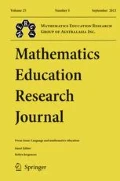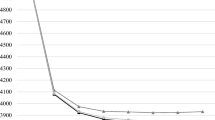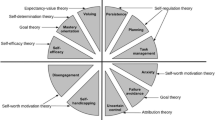Abstract
Student engagement in mathematics in the early secondary years can be fragile. Engagement in learning fluctuates in response to students’ mathematics experiences and is underpinned by numerous adaptive and maladaptive factors. Thirty-seven 11–12 year old students (grades 6–7) responded twice to a questionnaire to measure shifts in their engagement and motivation over a 1-year period as they transitioned from primary to secondary school. When plotted on spider graphs, the results of specific adaptive and maladaptive factors visually demonstrate “in and out” movements as students’ engagement levels shifted from time 1 to time 2. Subsequent semistructured interviews complemented questionnaire data by eliciting student beliefs about their achievement, feelings and behaviours towards mathematics. Interview data shed light on the reasons for individual student shifts in motivation and engagement during the transition. Together, data reveal four unique engagement/achievement characteristics. Significantly, students who were more alike in terms of their engagement reported similar factor patterns regardless of their achievement level. Findings draw attention to the importance of addressing mathematics engagement for students of all achievement levels.





Similar content being viewed by others
References
Attard, C. (2013). “If I had to pick any subject it wouldn’t be maths”: foundations for engagement with mathematics in the middle years. Mathematics Education Research Journal, 13, 569–587.
Bandura, A. (1977). Self-efficacy: toward a unifying theory of behavioral change. Psychological Review, 84, 191–215.
Carey, E., Hill, F., Devine, A., & Szücs, D. (2016). The chicken or the egg? The direction of the relationship between mathematics anxiety and mathematics performance. Frontiers in Psychology, 6, 1987. https://doi.org/10.3389/fpsyg.2015.01987.
Cleary, T. J., & Zimmerman, B. J. (2012). A cyclical self-regulation account of student engagement: Theoretical foundations and applications. In S. L. Christenson, A. L. Reschly, & C. Wylie (Eds.), Handbook of research on student engagement (pp. 237–258). New York: Springer.
COAG. (2008). National numeracy review report. Canberra. Retrieved from https://alearningplace.com.au/wp-content/uploads/2016/02/National-Numeracy-Review.pdf
Connell, J. P., & Welborn, J. G. (1991). Competence, autonomy and relatedness: A motivational analysis of self-systems processes. In M. Gunnar & L. A. Sroufe (Eds.), Minnesota symposia on child psychology (Vol. 23, pp. 43–77). Hillsdale: Lawrence Erlbaum.
Covington, M. V. (2000). Goal theory, motivation, and school achievement: an integrative review. Annual Review of Psychology, 51, 171–200.
Dinham, S., & Rowe, K. (2007). Teaching and learning in middle schooling: A review of the literature. Camberwell: Australian Council for Educational Research.
Durksen, T. L., Way, J., Bobis, J., Anderson, J., Skilling, K., & Martin, A. J. (2017). Motivation and engagement in mathematics: A qualitative framework for teacher-student interactions. Mathematics Education Research Journal, v29 n2 p163-181 June 2017.
Dweck, C. S. (2000). Self-theories: Their role in motivation, personality, and development. Philadelphia: Psychology Press.
Eccles, J. S., & Wigfield, A. (2002). Motivational beliefs, values, and goals. Annual Review of Psychology, 53, 109–132.
Fredricks, J. A., & McColsky, W. (2012). The measurement of student engagement: A comparative analysis of various methods and student self-report instruments. In S. L. Christenson, A. L. Reschly, & C. Wylie (Eds.), Handbook of research on student engagement (pp. 763–782). New York: Springer.
Fredricks, J. A., Blumenfeld, P. C., & Paris, A. H. (2004). School engagement: potential of the concept, state of the evidence. Review of Educational Research, 74, 59–109.
Fredricks, J. A., Filsecker, M., & Lawson, M. A. (2016). Student engagement, context and adjustment: addressing definitional, measurement, and methodological issues. Learning and Instruction, 43, 1–4.
Harris, L. (2011). Secondary teachers’ conceptions of student engagement: engagement in learning or in schooling? Teaching and Teacher Education, 27, 376–386.
Krippendorf, K. (2004). Reliability in content analysis: some common misconceptions and recommendations. Human Communication Research, 30(3), 411–433.
Lutz, S., Guthrie, J., & Davis, M. (2010). Scaffolding for engagement in elementary school reading instruction. The Journal of Educational Research, 100(1), 3-20
Martin, A. (2003). The Student Motivation Scale: further testing of an instrument that measures students' motivation. Australian Journal of Education, 47(1), 88–106.
Martin, A. (2007). Examining a multidimensional model of student motivation and engagement using a construct validation approach. British Journal of Educational Psychology, 77(2), 413–440.
Martin, A., Anderson, J., Bobis, J. Way, J., Vellar, R. (2012) Switching on and switching off in mathematics: An ecological study of future intent and disengagement among middle school students.. Journal of Educational Psychology 104 (1):1-18
Martin, A., Bobis, J., Anderson, J., Way, J., Vellar, R. (2011) Patterns of Multilevel Variance in Psycho-Educational Phenomena: Comparing Motivation, Engagement, Climate, Teaching, and Achievement Factors 1Dieser Beitrag wurde unter der geschäftsführenden Herausgeberschaft von Jens Möller angenommen.. Zeitschrift für Pädagogische Psychologie 25 (1):49-61
Middleton, J. A., & Spanias, P. A. (1999). Motivation for achievement in mathematics: findings, generalizations, and criticisms of the research. Journal of Research in Mathematics Education, 30(1), 65–88.
Nardi, E., & Steward, S. (2003). Is mathematics T.I.R.E.D? A profile of quiet disaffection in the secondary mathematics classroom. British Educational Research Journal, 28(3), 346–367.
OECD. (2013). PISA 2012 results: ready to learn: student engagement, drive and self beliefs Vol 3. Retrieved from https://www.oecd.org/pisa/keyfindings/pisa-2012-results-volume-III.pdf.
QRS-International. (2008). NVivo qualitative data analysis, version 8. Cambridge: QRS International Pty Ltd..
Reeve, J. R. (2009). Why teachers adopt a controlling motivating style toward students and how they can become more autonomy supportive. Educational Psychologist, 44(3), 159–175.
Reeve, J. R. (2012). A self-determination theory perspective on student engagement. In S. L. Christenson, A. L. Reschly, & C. Wylie (Eds.), Handbook of research on student engagement (pp. 149–172). New York: Springer.
Reschly, A. L., & Christenson, S. L. (2012). Jingle, jangle, and conceptual haziness: Evolution and future directions of the engagement construct. In S. L. Christenson, A. L. Reschly, & C. Wylie (Eds.), Handbook of research on student engagement (pp. 3–19). New York: Springer.
Richardson, V. (1996). The role of attitudes and beliefs in learning to teach. In J. Sikula (Ed.), Handbook of research on teacher education (pp. 102–119). New York: Macmillan.
Ryan, R. M., & Deci, E. L. (2000). Self-determination theory and the facilitation of intrinsic motivation, social development, and well-being. American Psychologist, 5, 68–78.
Shernoff, D. J. (2013). Optimal learning environments to promote student engagement. New York: Springer Available from https://www.springer.com/gp/book/9781461470885.
Skilling, K., Bobis, J., & Martin, A. (2015). The Engagement of students with high and low achievement levels in mathematics. In Beswick, K., Muir, T., Wells, J. (Eds.), Proceedings of the 39th Psychology of Mathematics Education conference (Vol. 4, pp. 185-192). Hobart, Australia: PME
Skilling, K., Bobis, J., Martin, A. J., Anderson, J., & Way, J. (2016). What secondary teachers think and do about student engagement in mathematics. Mathematics Education Research Journal, v 28, n4, p545-566.
Skilling, K. & Stylianides, G.J. (2019). Using vignettes in education research: a framework for vignette construction. https://doi.org/10.1080/1743727X.2019.1704243
Skinner, E. A. (2016). Engagement and disaffection as central to processes of motivational resilience and development. In K. R. Wentzel & D. B. Miele (Eds.), Handbook of motivation at school (pp. 145–168). New York: Routledge.
Skinner, E. A., & Pitzer, J. R. (2012). Developmental dynamics of student engagement, coping and everyday resilience. In S. L. Christenson, A. L. Reschly, & C. Wylie (Eds.), Handbook of research on student engagement (pp. 21–44). New York: Springer.
Stipek, D., Salmon, J. M., Givven, K. B., Kazemi, E., Saxe, G., & MacGyvers, V. L. (1998). The value (and convergence) of practices suggested by motivation research and promoted by mathematics education reformers. Journal of Research in Mathematics Education, 29(4), 465–488.
Stylianides, A. J., & Stylianides, G. J. (2014). Impacting positively on students’ mathematical problem solving beliefs: an instructional intervention of short duration. The Journal of Mathematical Behaviour, 33, 8–29.
Sullivan, P., Tobias, S., & McDonough, A. (2006). Perhaps the decision of some students not to engage in learning mathematics in school is deliberate. Educational Studies in Mathematics, 62(1), 81–99.
Turner, J. C., Warzon, K., & Christenson, A. (2011). Motivating mathematics learning: changes in teachers’ practices and beliefs during a nine-month collaboration. American Educational Research Journal, 48(3), 718–762.
Walter, J. G., & Hart, J. (2009). Understanding the complexities of student motivations in mathematics learning. The Journal of Mathematics Behavior, 28, 162–170.
Watson, A. (2010). Shifts in mathematical thinking in adolescence. Research in Mathematics Education, 12(2), 133–148.
Weiner, B. (1985). An attribution theory of achievement motivation and emotion. Psychological Review, 92, 548–573.
Wigfield, A., & Eccles, J. S. (2002). The development of competence beliefs, expectancies for success, and achievement value from childhood through adolescence. In A. Wigfield & J. S. Eccles (Eds.), The development of achievement motivation. San Diego: Academic Press.
Wilkinson, G. S. (1983). Wide range achievement test–3. Wilmington: Wide Range Inc..
Funding
This research was funded by an Australian Research Council Linkage Project grantLP0776843 in partnership with the Catholic Education Office, Sydney.
Author information
Authors and Affiliations
Corresponding author
Additional information
Publisher’s note
Springer Nature remains neutral with regard to jurisdictional claims in published maps and institutional affiliations.
Rights and permissions
About this article
Cite this article
Skilling, K., Bobis, J. & Martin, A.J. The “ins and outs” of student engagement in mathematics: shifts in engagement factors among high and low achievers. Math Ed Res J 33, 469–493 (2021). https://doi.org/10.1007/s13394-020-00313-2
Received:
Accepted:
Published:
Issue Date:
DOI: https://doi.org/10.1007/s13394-020-00313-2




